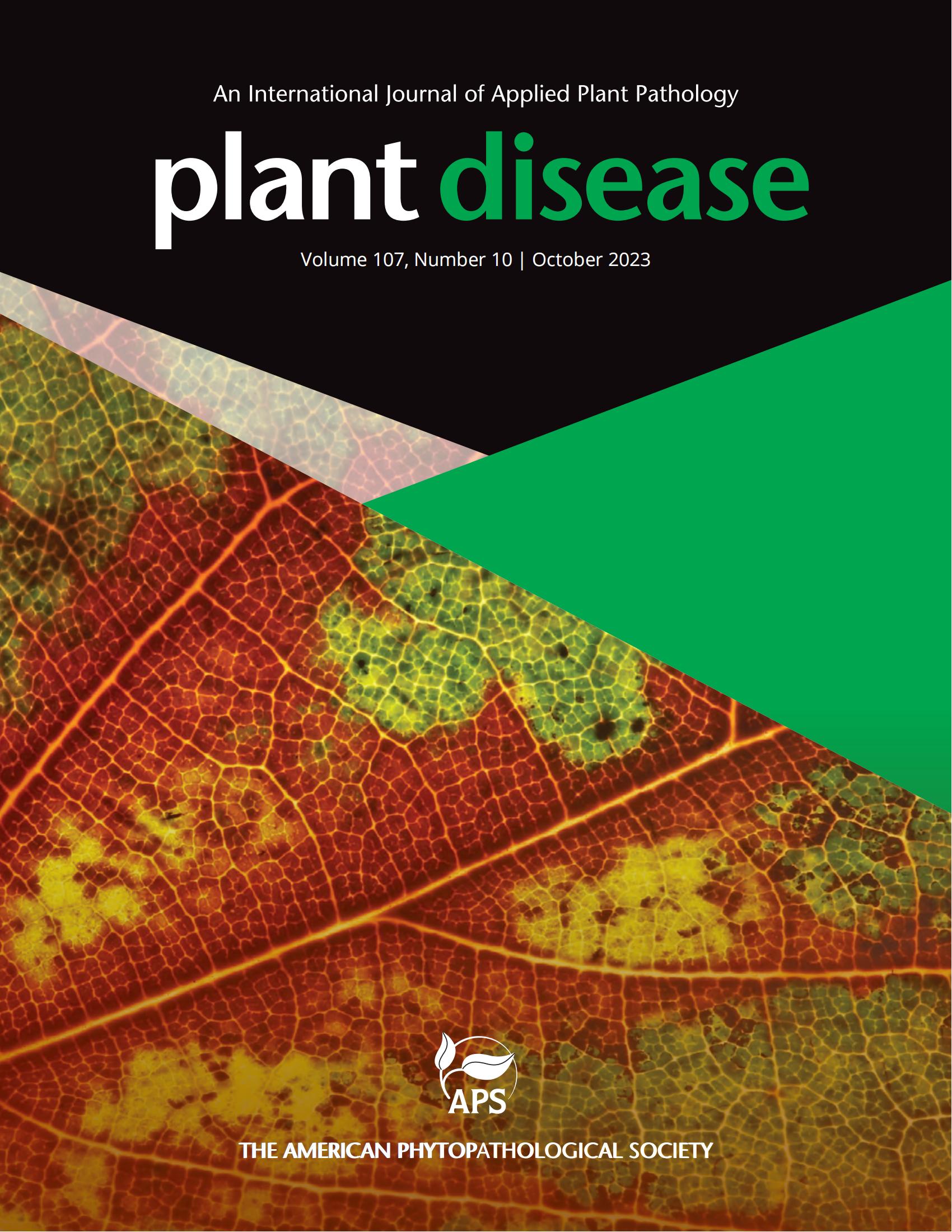首次报告与美国马里兰州弗吉尼亚州爬山虎有关的榆树黄化病组(16SrV)植原体菌株。
摘要
弗吉尼亚爬山虎(Parthenocissus quinquefolia [L.] Planch.)是葡萄科落叶开花藤本植物。它原产于北美洲东部,由于生长迅速,秋季叶色艳丽,常被用作攀援藤本植物或地面覆盖物进行观赏。2022 年 7 月,在马里兰州兰哈姆一处私人住宅的外墙上,发现两株弗吉尼亚爬山虎 (VC) 藤蔓出现黄色斑驳和叶片过早变红的症状。为了调查这些症状的原因,我们从同一附近的第三棵葡萄树上采集了两份有症状的叶片样本和一份无症状的叶片样本,以便进行进一步分析。按照生产商的说明,使用 Qiagen DNeasy Plant Mini Kit 提取叶片组织中的总 DNA。使用植原体特异性实时 PCR(Hodgetts 等人,2009 年)检测 DNA 提取物,结果检测到有症状的两株葡萄树的 DNA 样本中存在植原体。然后用引物 P1/16S-SR 和 P1A/16S-SR (Deng 和 Hiruki,1991 年;Lee 等人,2004 年)通过半ested PCR 从这些样本中扩增出接近全长的 16S 核糖体 RNA 基因,并用引物 P1A 和 16S-SR 进行 Sanger 测序。对所获得的 16S rDNA 序列进行分析后发现,两个植物样本之间没有差异,其中一个序列被存入 GenBank,代表名为 VC-MD1 的植原体菌株(GenBank PP746981)。在 NCBI 核苷酸数据库中对 16S rRNA 基因序列进行 BLASTn 搜索后发现,该序列与来自华盛顿州红桤木的植原体菌株 AldY-WA1 (GenBank MZ557341)、与佛罗里达州南部 VC 植物相关的植原体(GenBank AF305198)(Harrison et al.2001),以及在欧洲葡萄藤中检测到的其他菌株,被描述为 "flavescence dorée" 植原体(GenBank AF176319)(Davis 和 Dally,2001)。通过 iPhyClassifier(赵等人,2009 年)得出的虚拟限制性片段长度多态性模式表明,VC-MD1 确实是 16SrV-C 植原体亚群的成员。为了证实这一鉴定结果,按照之前的描述(Lee 等人,2010 年;Makarova 等人,2012 年),扩增了部分 spc 操作子和部分 tuf 基因。具体而言,使用引物集 L15F1A-a/MapR1 和 L15F1A-b/MapR1A-b 嵌套 PCR 方法扩增了 spc 操作子区域。从这两个位点获得的序列数据已存入 GenBank,登录号分别为 PP746982(spc)和 PP746983(tuf)。通过 BLAST 搜索查询 spc 操作子和 tuf 基因的核苷酸序列,发现它们与 "Candidatus Phytoplasma rubi "菌株 RS(GenBank CP114006)和大麻狗尾草黄萎病病原菌菌株 HD1(GenBank FR686506)的相应位点分别有 95.39% 和 99.05% 的同一性。基于 secY 和 tuf 基因序列的系统进化分析表明,VC-MD1 株系在进化过程中与在美国不同宿主体内检测到的 16SrV-C 植原体株系最为接近,其中包括 HD1 和 AldY-WA1。这些北美菌株聚集在榆树黄化病群植原体的一个独特分支上。对于马里兰州来说,这次检测是首次报告 16SrV-C 亚群中的植原体菌株感染 VC 植物。此前,佛罗里达州曾在无症状的葡萄藤中检测到同一亚群的植原体(Harrison 等,2001 年)。这两种 VC 植原体菌株的 16S rRNA 基因序列几乎相同,仅有一个核苷酸的差异。VC-MD1 株系的疾病传播媒介和该地区的疾病流行情况仍未确定。Virginia creeper (Parthenocissus quinquefolia [L.] Planch.) is a deciduous flowering vine in the Vitaceae family. Native to eastern North America, it is often used ornamentally as a climbing vine or as ground cover due to its rapid growth and foliage color in the fall. In July of 2022, along exterior walls of a private property in Lanham, MD, two Virginia creeper (VC) vines were observed displaying symptoms of yellow mottling and premature reddening of leaves. To investigate the cause of these symptoms, two symptomatic leaf samples and one asymptomatic leaf samples from a third vine in the same vicinity were collected for further analysis. A Qiagen DNeasy Plant Mini Kit was used to extract total DNA from leaf tissues according to the manufacturer's instructions. A phytoplasma-specific real-time PCR (Hodgetts et al. 2009) was used to test the DNA extracts, which detected the presence of phytoplasmas in the two DNA samples derived from symptomatic vines. The near full-length of the 16S ribosomal RNA gene was then amplified by seminested PCR from these samples with primers P1/16S-SR followed by P1A/16S-SR (Deng, and Hiruki 1991; Lee et al. 2004) and Sanger sequenced using primers P1A and 16S-SR. Analysis of the obtained 16S rDNA sequences revealed no variation between the two plant samples, and one sequence was deposited in GenBank representing the phytoplasma strain named VC-MD1 (GenBank PP746981). A BLASTn search of the 16S rRNA gene sequence in the NCBI nucleotide database, showed 99.93% sequence identity with the phytoplasma strain AldY-WA1 (GenBank MZ557341) from red alder in Washington, a phytoplasma associated with VC plants in southern Florida (GenBank AF305198) (Harrison et al. 2001), and other strains detected in grapevines in Europe described as "flavescence dorée" phytoplasma (GenBank AF176319) (Davis, and Dally 2001). The virtual restriction fragment length polymorphism pattern derived from iPhyClassifier (Zhao et al. 2009), indicated that VC-MD1 is indeed a member of the 16SrV-C phytoplasma subgroup. To confirm the identification, the partial spc operon and the partial tuf gene were amplified as previously described (Lee et al. 2010; Makarova et al. 2012). Specifically, the spc operon region was amplified using a nested PCR approach with primer set L15F1A-a/MapR1 followed by L15F1A-b/MapR1A-b. Sequence data obtained from the two loci were deposited to GenBank with accession numbers PP746982 (spc) and PP746983 (tuf). BLAST searches querying the nucleotide sequences of the spc operon and tuf gene showed 95.39% and 99.05% identity, respectively, to the corresponding loci of 'Candidatus Phytoplasma rubi' strain RS (GenBank CP114006) and hemp dogbane yellows phytoplasma strain HD1 (GenBank FR686506). Phylogenetic analysis based on secY and tuf gene sequences suggest that the VC-MD1 strain is evolutionary closest to 16SrV-C phytoplasma strains detected in various hosts in the United States, including HD1 and AldY-WA1. These North American strains cluster together on a distinct branch within the elm yellows group phytoplasmas. For the State of Maryland, this detection represents the first report of a phytoplasma strain member of the16SrV-C subgroup infecting VC plants. A phytoplasma of the same subgroup was previously detected in Florida in asymptomatic VC vines (Harrison et al. 2001). The 16S rRNA gene sequences of the two VC phytoplasma strains are nearly identical, differing by just a single nucleotide. The disease transmission vectors of the VC-MD1 strain and the prevalence of the disease in the region remains undetermined.

 求助内容:
求助内容: 应助结果提醒方式:
应助结果提醒方式:


